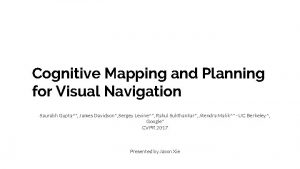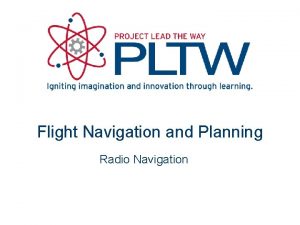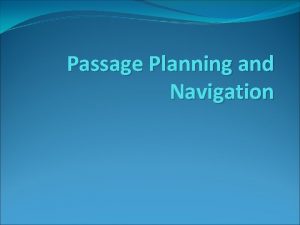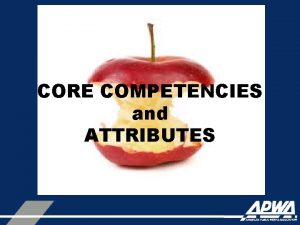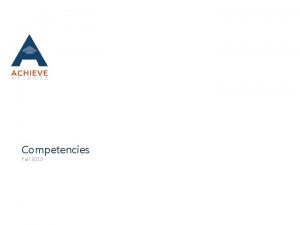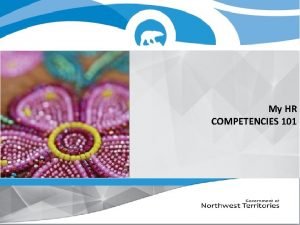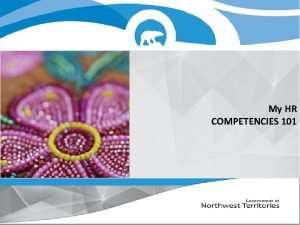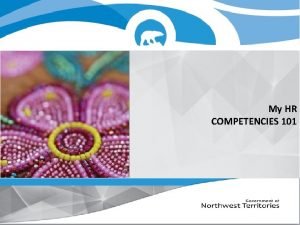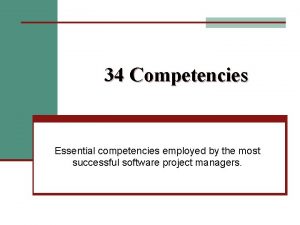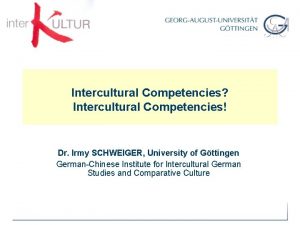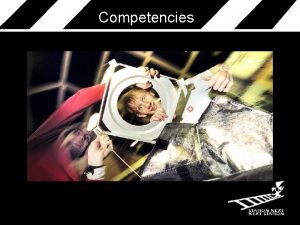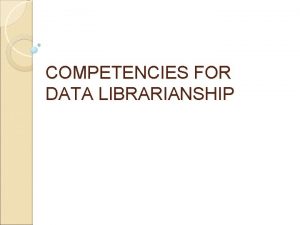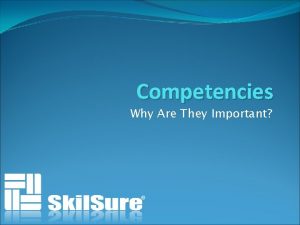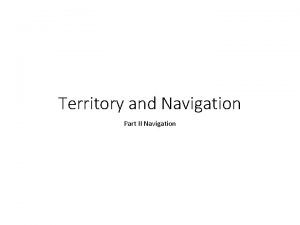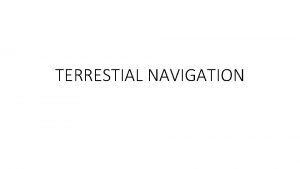Planning and Navigation Competencies for Navigation Navigation is





















![Attractive Potential Field q = [x, y]T qgoal = [xgoal, ygoal]T • Parabolic function Attractive Potential Field q = [x, y]T qgoal = [xgoal, ygoal]T • Parabolic function](https://slidetodoc.com/presentation_image_h/a8f823cd9e112f254e7b6ea13a701d03/image-22.jpg)























- Slides: 45

Planning and Navigation

Competencies for Navigation • Navigation is composed of localization, mapping and motion planning Localization "Position" Global Map Environment Model Local Map Perception Cognition Path Real World Environment Motion Control – Different forms of motion planning inside the 6 cognition loop from R. Siegwart

Outline of this Lecture • Motion Planning – State-space and obstacle representation • Work space • Configuration space – Global motion planning • • Optimal control (not treated) Deterministic graph search Potential fields Probabilistic / random approaches – Local collision avoidance • • BUG VFH ND. . .

The Planning Problem (1/2) • The problem: find a path in the work space (physical space) from the initial position to the goal position avoiding all collisions with the obstacles • Assumption: there exists a good enough map of the environment for navigation. – Topological – Metric – Hybrid methods

The Planning Problem (2/2) • We can generally distinguish between – (global) path planning and – (local) obstacle avoidance. • First step: – Transformation of the map into a representation useful for planning – This step is planner-dependent • Second step: – Plan a path on the transformed map • Third step: – Send motion commands to controller – This step is planner-dependent (e. g. Model based feed forward, path following)

Map Representations Topological Map (Continuous Coordinates) Occupancy Grid Map (Discrete Coordinates) K-d Tree Map (Quadtree) Large memory requirement of grid maps - > k-d tree recursively breaks the environment into k pieces - Here k = 4, quadtree

Topological Map

Topological Maps +Edges can carry weights +Standard Graph Theory Algorithms (Dijkstra's algorithm) +Good abstract representation ●Several graphs for any world ●Assumption: Robot can travel between nodes ●Tradeoff in # of nodes: complexity vs. accuracy - Limited information

Grid World Two dimensional array of values Each cell represents a square of real world Typically a few centimeters to a few dozen centimeters

Alternative Representations Waste lots of bits for big open spaces KD-trees x<5 free y<5 occupied free

Quad. Tree Oct. Tree

Work Space Configuration Space Example: manipulator robots • State or configuration q can be described with k values qi • What is the configuration space of a mobile robot? Work Space Configuration Space: Planning in configuration space the dimension of this space is equal to the Degrees of Freedom (Do. F) of the robot

Configuration Space for a Mobile Robot • Mobile robots operating on a flat ground have 3 Do. F: (x, y, θ) • For simplification, in path planning mobile roboticists often assume that the robot is holonomic and that it is a point. In this way the configuration space is reduced to 2 D (x, y) • Because we have reduced each robot to a point, we have to inflate each obstacle by the size of the robot radius to compensate.

Configuration Space for a Mobile Robot

Path Planning: Overview of Algorithms 1. Optimal Control – Solves truly optimal solution – Becomes intractable for even moderately complex as well as nonconvex problems 2. Potential Field 3. Graph Search – Identify a set edges between nodes within the free space Source: http: //mitocw. udsm. ac. tz – Imposes a mathematical function over the state/configuration space – Many physical metaphors exist – Often employed due to its simplicity and similarity to optimal control solutions Configuration Space for a Mobile Robot – Where to put the nodes?

Potential Field Path Planning Strategies Khatib, 1986 • Robot is treated as a point under the influence of an artificial potential field. • Operates in the continuum – Generated robot movement is similar to a ball rolling down the hill – Goal generates attractive force – Obstacle are repulsive forces 6 - Planning and Navigation 6 16

Potential Fields Oussama Khatib, 1986. Model navigation as the sum of forces on the robot Goal: Attractive Force Large Distance --> Large Force Model as Spring Hooke's Law F = -k X Obstacles: Repulsive Force Small Distance --> Large Force Model as Electrically Charged Particles Coulomb's law F= k q 1 q 2 / r 2

attractive

repulsive


Potential Field Generation • Generation of potential field function U(q) • Generate artificial force field F(q) • Set robot speed (vx, vy) proportional to the force F(q) generated by the field – the force field drives the robot to the goal 6 - Planning and Navigation 6 21
![Attractive Potential Field q x yT qgoal xgoal ygoalT Parabolic function Attractive Potential Field q = [x, y]T qgoal = [xgoal, ygoal]T • Parabolic function](https://slidetodoc.com/presentation_image_h/a8f823cd9e112f254e7b6ea13a701d03/image-22.jpg)
Attractive Potential Field q = [x, y]T qgoal = [xgoal, ygoal]T • Parabolic function representing the Euclidean distance to the goal • Attracting force converges linearly towards 0 (goal) 6 - Planning and Navigation 6 22

Repulsing Potential Field • Should generate a barrier around all the obstacle – strong if close to the obstacle – not influence if far from the obstacle minimum distance to the object, ρ0 distance of influence of object Field is positive or zero and tends to infinity as q gets closer to the object obst. 6

Repulsive potential field

Potential Field Path Planning: • Notes: – Local minima problem exists – problem is getting more complex if the robot is not considered as a point mass – If objects are non-convex there exists situations where several minimal distances exist ® can result in oscillations 6 - Planning and Navigation 6 25

Computing the distance • In practice the distances are computed using sensors, such as range sensors which return the closets distance to obstacles

Graph Algorithms Methods – Breath First – Depth First – Dijkstra – A* and variants – D* and variants –. . .

Graph Construction: Cell Decomposition (1/4) • Divide space into simple, connected regions called cells • Determine which open cells are adjacent and construct a connectivity graph • Find cells in which the initial and goal configuration (state) lie and search for a path in the connectivity graph to join them. • From the sequence of cells found with an appropriate search algorithm, compute a path within each cell. – e. g. passing through the midpoints of cell boundaries or by sequence of wall following movements. • Possible cell decompositions: – Exact cell decomposition – Approximate cell decomposition: • • Fixed cell decomposition Adaptive cell decomposition 6 - Planning and Navigation

Graph Construction: Exact Cell Decomposition (2/4) 6 - Planning and Navigation 6 29

Graph Construction: Approximate Cell Decomposition (3/4) 6 - Planning and Navigation 6 30

Graph Construction: Adaptive Cell Decomposition (4/4) 6 - Planning and Navigation 6 31

Graph Search Strategies: Breadth-First Search 6

Dijkstra’s Algorithm A generic path planning problem from vertex I to vertex VI. The shortest path is I-II-III-V-VI with length 13. Often highly inefficient

Dijkstra’s Algorithm on a Grid

Graph Search Strategies: A* Search § Similar to Dijkstra‘s algorithm, except that it uses a heuristic function h(n) § f(n) = g(n) + ε h(n) 6 - Planning and Navigation 6 35

Dijkstra plus directional heuristic: A*

Graph Search Strategies: D* Search § Similar to A* search, except that th search starts from the goal outward § f(n) = g(n) + ε h(n) § First pass is identical to A* § Subsequent passes reuse information from previous searches § For example when after executing the algorithm for a few times, new obstacles appear.

Sampling-based Path Planning (or Randomized graph search) • When the state space is large complete solutions are often infeasible. • In practice, most algorithms are only resolution complete, i. e. , only complete if the resolution is ne-grained enough • Sampling-based planners create possible paths by randomly adding points to a tree until some solution is found

Rapidly Exploring Random Tree (RRT) § Well suited for high-dimensional search spaces § Often produces highly suboptimal solutions

Probabilistic Roadmaps (PRM) • create a tree by randomly sampling points in the state-space • test whether they are collision-free • connect them with neighboring points using paths that reflects the kinematics of a robot • use classical graph shortest path algorithms to find shortest paths on the resulting structure.

Planning at different length-scales

Take-home lessons • First step in addressing a planning problem is choosing a suitable map representation • Reduce robot to a point-mass by inflating obstacles • Grid-based algorithms are complete, sampling-based ones probabilistically complete, but usually faster • Most real planning problems require combination of multiple algorithms

Obstacle Avoidance (Local Path Planning) • tacle n obs p) s (ma rved o b se l e ac o b st w(t) ath ed p Plan – the overall goal – the actual speed and kinematics of the robot – the on boards sensors – the actual and future risk of collision v(t), • know • • The goal of the obstacle avoidance algorithms is to avoid collisions with obstacles It is usually based on a local map Often implemented as a more or less independent task However, efficient obstacle avoidance should be optimal with respect to • Example: Alice 6 - Planning and Navigation 6 43

Obstacle Avoidance: Bug 1 • Following along the obstacle to avoid it • Each encountered obstacle is once fully circled before it is left at the point closest to the goal • Advantages – No global map required – Completeness guaranteed • Disadvantages – Solutions are often highly suboptimal 6 - Planning and Navigation 6 44

Obstacle Avoidance: Bug 2 • Following the obstacle always on the left or right side • Leaving the obstacle if the direct connection between start and goal is crossed 6 - Planning and Navigation 6 45
 Cognitive mapping and planning for visual navigation
Cognitive mapping and planning for visual navigation Fspos
Fspos Typiska drag för en novell
Typiska drag för en novell Nationell inriktning för artificiell intelligens
Nationell inriktning för artificiell intelligens Ekologiskt fotavtryck
Ekologiskt fotavtryck Varför kallas perioden 1918-1939 för mellankrigstiden?
Varför kallas perioden 1918-1939 för mellankrigstiden? En lathund för arbete med kontinuitetshantering
En lathund för arbete med kontinuitetshantering Personalliggare bygg undantag
Personalliggare bygg undantag Tidböcker
Tidböcker A gastrica
A gastrica Densitet vatten
Densitet vatten Datorkunskap för nybörjare
Datorkunskap för nybörjare Boverket ka
Boverket ka Mall för debattartikel
Mall för debattartikel Delegerande ledarskap
Delegerande ledarskap Nyckelkompetenser för livslångt lärande
Nyckelkompetenser för livslångt lärande Påbyggnader för flakfordon
Påbyggnader för flakfordon Formel för lufttryck
Formel för lufttryck Publik sektor
Publik sektor Jag har nigit för nymånens skära text
Jag har nigit för nymånens skära text Presentera för publik crossboss
Presentera för publik crossboss Teckenspråk minoritetsspråk argument
Teckenspråk minoritetsspråk argument Kanaans land
Kanaans land Treserva lathund
Treserva lathund Mjälthilus
Mjälthilus Claes martinsson
Claes martinsson Cks
Cks Programskede byggprocessen
Programskede byggprocessen Mat för unga idrottare
Mat för unga idrottare Verktyg för automatisering av utbetalningar
Verktyg för automatisering av utbetalningar Rutin för avvikelsehantering
Rutin för avvikelsehantering Smärtskolan kunskap för livet
Smärtskolan kunskap för livet Ministerstyre för och nackdelar
Ministerstyre för och nackdelar Tack för att ni har lyssnat
Tack för att ni har lyssnat Vad är referatmarkeringar
Vad är referatmarkeringar Redogör för vad psykologi är
Redogör för vad psykologi är Stål för stötfångarsystem
Stål för stötfångarsystem Tack för att ni har lyssnat
Tack för att ni har lyssnat Borra hål för knoppar
Borra hål för knoppar Vilken grundregel finns det för tronföljden i sverige?
Vilken grundregel finns det för tronföljden i sverige? Standardavvikelse formel
Standardavvikelse formel Tack för att ni har lyssnat
Tack för att ni har lyssnat Steg för steg rita
Steg för steg rita Ledningssystem för verksamhetsinformation
Ledningssystem för verksamhetsinformation Tobinskatten för och nackdelar
Tobinskatten för och nackdelar Toppslätskivling effekt
Toppslätskivling effekt
